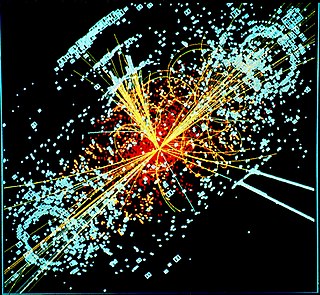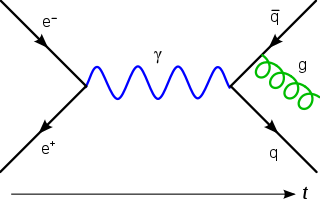The mathematical formulations of quantum mechanics are those mathematical formalisms that permit a rigorous description of quantum mechanics. Such are distinguished from mathematical formalisms for theories developed prior to the early 1900s by the use of abstract mathematical structures, such as infinite-dimensional Hilbert spaces and operators on these spaces. Many of these structures are drawn from functional analysis, a research area within pure mathematics that was influenced in part by the needs of quantum mechanics. In brief, values of physical observables such as energy and momentum were no longer considered as values of functions on phase space, but as eigenvalues; more precisely as spectral values of linear operators in Hilbert space.
In physics and computer science, quantum information is the information of the state of a quantum system; it is the basic entity of study in quantum information theory, and can be manipulated using quantum information processing techniques. Quantum information, like classical information, can be processed using digital computers, transmitted from one location to another, manipulated with algorithms, and analyzed with the computer science mathematics. While the fundamental unit of classical information is the bit, the most basic unit of quantum information is the qubit.
Quantum teleportation is a process by which quantum information can be transmitted from one location to another, with the help of classical communication and previously shared quantum entanglement between the sending and receiving location. Because it depends on classical communication, which can proceed no faster than the speed of light, it cannot be used for faster-than-light transport or communication of classical bits. While it has proven possible to teleport one or more qubits of information between two (entangled) quanta, this has not yet been achieved between anything larger than molecules.

Loop quantum gravity (LQG) is a theory of quantum gravity, merging quantum mechanics and general relativity, making it a possible candidate for a theory of everything. Its goal is to unify gravity in a common theoretical framework with the other three fundamental forces of nature, beginning with relativity and adding quantum features. It competes with string theory that begins with quantum field theory and adds gravity.
In mathematics, a monoidal category is a category C equipped with a bifunctor

In mathematics, specifically in the representation theory of groups and algebras, an irreducible representation or irrep of an algebraic structure is a nonzero representation that has no proper subrepresentation closed under the action of .
In gauge theory, a Wilson loop is a gauge-invariant observable obtained from the holonomy of the gauge connection around a given loop. In the classical theory, the collection of all Wilson loops contains sufficient information to reconstruct the gauge connection, up to gauge transformation.
Quantum error correction (QEC) is used in quantum computing to protect quantum information from errors due to decoherence and other quantum noise. Quantum error correction is essential if one is to achieve fault-tolerant quantum computation that can deal not only with noise on stored quantum information, but also with faulty quantum gates, faulty quantum preparation, and faulty measurements.
Coherent information is an entropy measure used in quantum information theory. It is a property of a quantum state ρ and a quantum channel ; intuitively, it attempts to describe how much of the quantum information in the state will remain after the state goes through the channel. In this sense, it is intuitively similar to the mutual information of classical information theory. The coherent information is written .
In physics, the no-communication theorem or no-signaling principle is a no-go theorem from quantum information theory which states that, during measurement of an entangled quantum state, it is not possible for one observer, by making a measurement of a subsystem of the total state, to communicate information to another observer. The theorem is important because, in quantum mechanics, quantum entanglement is an effect by which certain widely separated events can be correlated in ways that suggest the possibility of instantaneous communication. The no-communication theorem gives conditions under which such transfer of information between two observers is impossible. These results can be applied to understand the so-called paradoxes in quantum mechanics, such as the EPR paradox, or violations of local realism obtained in tests of Bell's theorem. In these experiments, the no-communication theorem shows that failure of local realism does not lead to what could be referred to as "spooky communication at a distance".

In quantum information theory, superdense coding is a quantum communication protocol to transmit two classical bits of information from a sender to a receiver, by sending only one qubit from Alice to Bob, under the assumption of Alice and Bob pre-sharing an entangled state. This protocol was first proposed by Bennett and Weisner in 1992 and experimentally actualized in 1996 by Mattel, Weinfurter, Kwiat and Zeilinger using entangled photon pairs. By performing one of four quantum gate operations on the (entangled) qubit she possesses, Alice can prearrange the measurement Bob makes. After receiving Alice's qubit, operating on the pair and measuring both, Bob has two classical bits of information. If Alice and Bob do not already share entanglement before the protocol begins, then it is impossible to send two classical bits using 1 qubit, as this would violate Holevo's theorem.
In quantum information theory, the no-teleportation theorem states that an arbitrary quantum state cannot be converted into a sequence of classical bits ; nor can such bits be used to reconstruct the original state, thus "teleporting" it by merely moving classical bits around. Put another way, it states that the unit of quantum information, the qubit, cannot be exactly, precisely converted into classical information bits. This should not be confused with quantum teleportation, which does allow a quantum state to be destroyed in one location, and an exact replica to be created at a different location.
In quantum information theory, the channel-state duality refers to the correspondence between quantum channels and quantum states. Phrased differently, the duality is the isomorphism between completely positive maps (channels) from A to Cn×n, where A is a C*-algebra and Cn×n denotes the n×n complex entries, and positive linear functionals (states) on the tensor product
Entanglement distillation is the transformation of N copies of an arbitrary entangled state into some number of approximately pure Bell pairs, using only local operations and classical communication (LOCC).

In physics, a gauge theory is a type of field theory in which the Lagrangian is invariant under certain Lie groups of local transformations.
Quantum block codes are useful in quantum computing and in quantum communications. The encoding circuit for a large block code typically has a high complexity although those for modern codes do have lower complexity.
In quantum field theory, a Ward–Takahashi identity is an identity between correlation functions that follows from the global or gauge symmetries of the theory, and which remains valid after renormalization.
In the theory of quantum communication, the quantum capacity is the highest rate at which quantum information can be communicated over many independent uses of a noisy quantum channel from a sender to a receiver. It is also equal to the highest rate at which entanglement can be generated over the channel, and forward classical communication cannot improve it. The quantum capacity theorem is important for the theory of quantum error correction, and more broadly for the theory of quantum computation. The theorem giving a lower bound on the quantum capacity of any channel is colloquially known as the LSD theorem, after the authors Lloyd, Shor, and Devetak who proved it with increasing standards of rigor.
In quantum mechanics, weak measurements are a type of quantum measurement that results in an observer obtaining very little information about the system on average, but also disturbs the state very little. From Busch's theorem the system is necessarily disturbed by the measurement. In the literature weak measurements are also known as unsharp, fuzzy, dull, noisy, approximate, and gentle measurements. Additionally weak measurements are often confused with the distinct but related concept of the weak value.






